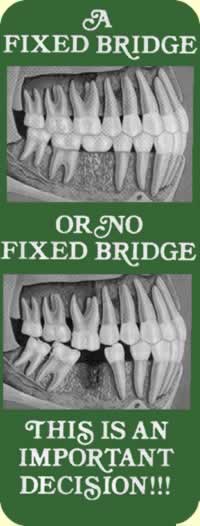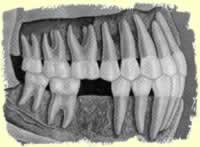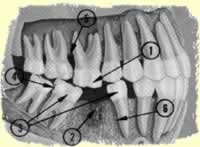Right_Box_Heading2
Paragraph_Content Add_More_Link
Crowns & Bridges

In a normal, healthy mouth (shown below), chewing function is well balanced and almost automatic since each upper tooth has proper contact and function with corresponding lower teeth. Because of this natural proper balance, undue strain or irritation on the gum tissue and bone is non-existent. Drifting or spreading of teeth does not occur and oral hygiene is easily maintained.
But, this natural proper balance is quickly destroyed when a tooth is lost.

A functional mouth has 28 teeth—14 upper and 14 lower—which support each other and function together in harmony. Each tooth has three or four companion teeth; its neighboring teeth and one or two biting partners in the opposite arch. Teeth greatly depend on these companion teeth for support and stability.
When a tooth loses one of its neighbors of opposing biting partners, that tooth (at least to some degree) then stands alone.
Without the support and stabilizing influence of its last companion, the neighbor tooth will be subjected to many problems—drifting, shifting, abnormally exposing decay prone areas, and periodontal disease (pyorrhea).
Statistics tell us that this neighbor tooth will be lost next. Then, the next closest neighbor will be subjected to the same problems, but with each lost tooth the problems are magnified. That next closest neighbor will soon be lost for the same reasons. This same process will continue to cause the loss of more teeth.
The cycle is vicious and unending. The mouth with missing teeth is very much out of natural proper balance. Eventually the destruction will be complete.

Shown above is an x-ray of a typical missing tooth area. The patient is a 17-year old female. Notice how the lower molar (arrow) drifts into the space created by the lost tooth. Note, also, that the tooth tends to lie down and that the molars develop an abnormal contact. This creates a situation in which abnormal forces are directed against one or more teeth.
It is natural to assume that intelligent people will do whatever is necessary to protect their dental health. So, let’s talk more about the fixed bridge.
First, let’s define come terms:
The FIXED BRIDGE is the cemented replacement for missing teeth. It may be constructed of gold or porcelain faced gold where appearance is important. The fixed bridge restores normal function and stabilization by providing the remaining teeth with neighbors and biting partners.
ABUTMENT TEETH are the teeth to which a fixed bridge is attached. ABUTMENT INLAYS or CROWNS are the dental restorations which fasten the bridge to the abutment teeth.
The PONTIC is the portion of the bridge which actually replaces the missing tooth. The pontic is fastened to the abutment inlays or crowns with soldered connectors.
The FIXED BRIDGE:
- Replaces missing teeth
- Helps balance a normal bite
- Helps prevent unnatural stress on the dental ridge
- Prevents over-eruption of opposing teeth
- Prevents drift and tilt of adjacent teeth
- Helps prevent formation of decay in abnormal areas
- Helps delay onset of Periodontal Disease (bone destruction)
Now let’s tell the story in pictures and pointout how the fixed bridge protects dental health by helping maintain the natural proper balance.
Imagine that a lower molar has been lost.

As you will see, its neighbors and biting partners are jeopardized.
They are vulnerable to abnormal decay areas, instability and bone loss (periodontal disease). In this case, if the lower molar is not replaced, the entire mouth can be affected.
This is what can happen:

- The opposing molar may super-erupt.
- The unprotected ridge is subject to trauma.
- The neighbor teeth tilt and proper functional balance is destroyed.
- The drifting teeth create food impact areas where decay starts— or where Periodontal Disease (Pyorrhea) can start.
- Destruction to the bone will result as teeth drift and tip.
To prevent this unfortunate set of circumstances from occurring, let’s construct a fixed bridge at the proper time—immediately after the tooth is lost. Let’s use porcelain-faced gold crowns (*) as bridge abutments. Gold forms the inner thimble which fits over the prepared tooth. The gold is not visible in this case because of the porcelain fused to it.

Now, diagrammatically, let’s add the pontic with is actually soldered to the abutment crowns. The connecting solder joints are hidden beneath the porcelain.

The completed fixed bridge (crown abutments and pontic) is now cemented in place to restore the natural proper balance.


